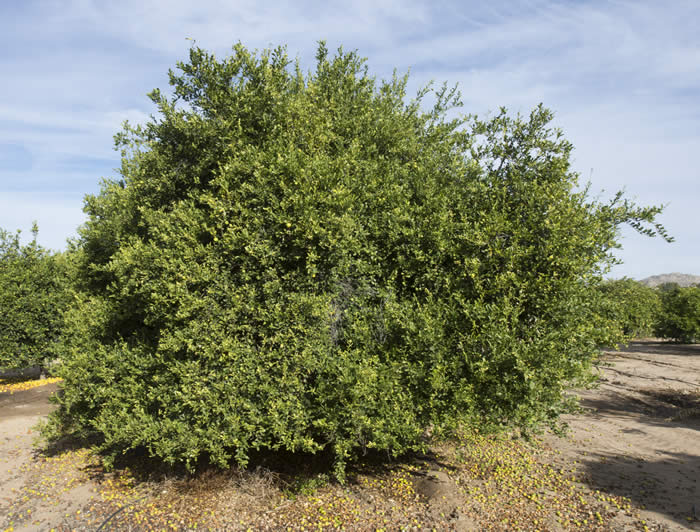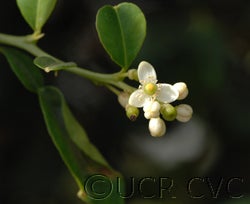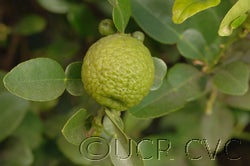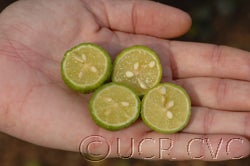Citrus micrantha var. microcarpa
CRC 3605
PI 539694
Source
Received as seed by the College of Agriculture, Laguna, Philippines, 1967.
Parentage/origins
Parents unknown. From Cebu.
Rootstocks of accession
Carrizo citrange, C-35 citrange
Season of ripeness at Riverside
Unknown at this time.
Notes and observations
1/14/1988, EMN: Probably monoembryonic. Citrus Industry description is OK- fits fruit pretty well. Flavor is awful.
Description from The Citrus Industry Vol. 1 (1967)
"Citrus micrantha var. microcarpa
Distribution.—Southern Philippines: Cebu and Bohol.
Common name.—Small-fruited papeda. Native name: Samuyao.
The original description of this variety by Wester reads as follows: "A shrubby tree, 4.5 meters tall, with slender branches and small, weak spines; leaves 55 to 80 millimeters long, 20 to 25 millimeters broad, ovate to ovate-oblong or elliptical, crenulate, thin, of distinct fragrance, base rounded to broadly acute; apex obtuse, sometimes notched, petioles 20 to 30 millimeters long, broadly winged, about 14 millimeters wide, wing area somewhat less than one-half of the leaf blade; flowers in compact axillary or terminal cymes, 2 to 7, small, 5 to 9 millimeters in diameter, white, with trace of purple on the outside; calyx small, not cupped, petals 3 to 5; stamens 15 to 18, free, equal; ovary very small, globose to obovate; locules 7 to 9, style distinct; stigma small, knob like; fruit 15 to 20 millimeters in diameter, roundish in outline; base sometimes nippled; apex an irregular, wrinkly cavity; surface corrugate, greenish lemon yellow; oil cells usually sunken; skin very thin; pulp fairly juicy, acid, bitter with distinct aroma; juice cells very minute, blunt, containing a small greenish nucleus; seeds small, flattened, sometimes beaked."
The samuyao was found by West and Brown (1920, pp. 208-09) to yield from the rind "a clear, almost colorless oil which is very fragrant. It should be useful as a perfumery oil." The peel yielded 1.29 per cent of oil. They stated that the crushed fruits are used by the women of Cebu for cleansing the hair and are added to coconut oil to give it fragrance when applied to the hair. The tree bears within five years from planting and produces fruits during the entire year, but more abundantly during the rainy season. West and Brown (1920, fig. 70) show the fruits as distinctly pyriform, broadly rounded at the tip and tapering into a narrow, conical base.
This variety has the smallest fruit and the smallest flowers of any True Citrus Fruit Tree known but curiously enough has more segments in the fruit (seven to nine) than C. micrantha (six to eight), although the fruits of the latter are much larger, 5 to 7 by 3 to 4 cm, instead of 1.5 to 2 cm, as in the variety microcarpa.
Wester stated (1915, p. 22) that in Bohol Island, P.I., "a somewhat more vigorous variety of the samuyao was found that is called samuyao-sa-amoo" which has "fruits a little larger, and smoother, and longer than broad, otherwise similar to the samuyao." This description calls to mind Rumphius' Limonellus aurarius, the goldsmith's lime, which occurs sparingly in Amboina, Moluccas, and Ternate, a few hundred miles directly south of Bohol. According to Rumphius (1741, vol. 2, p. 109, pl. 30), the fruits of this plant are the smallest of all the limes (his figure shows ovoid fruits 2.5 to 3 by 2 to 2.5 cm) and the leaves are also small, only 3 inches long in all, about one-third of which represents the cordate, winged petiole. The fruits are not eaten but are used by goldsmiths to clean gold objects. The fruits also enter into native medicines.
Both C. micrantha and its variety microcarpa are of much scientific interest, as they are perhaps the most primitive members of the subgenus Papeda, itself the most primitive group of species of the genus Citrus."
Availability
Not commercially available in California.
USDA Germplasm Resources Information Network page for Samuyao papeda





